

Talend Open Studio and MuleSoft Composer are competitors in the data integration and automation market. MuleSoft Composer holds the advantage due to its comprehensive features and scalability, making it the preferred choice despite higher costs.
Features: Talend Open Studio offers robust ETL capabilities with extensive connectivity options and is open-source, making it cost-effective. MuleSoft Composer focuses on integration simplicity, low-code tools, and seamless Salesforce integration for rapid deployment and CRM focus.
Room for Improvement: Talend Open Studio could improve its user interface, enhance support for non-technical users, and streamline deployment processes. MuleSoft Composer may need to address its cost barriers, expand integration capabilities beyond Salesforce, and improve customization options for advanced users.
Ease of Deployment and Customer Service: Talend Open Studio is flexible in deployment and supported by a strong community, which is ideal for organizations with technical expertise, though it has a steep learning curve. MuleSoft Composer offers a low-code, smooth deployment experience with more structured customer service, aiding less technical teams.
Pricing and ROI: Talend Open Studio is known for its cost-effectiveness, thanks to its open-source model, appealing to budget-conscious organizations. Although MuleSoft Composer has higher setup costs, its advanced features and integration efficiencies potentially offer greater ROI, justifying the investment for companies requiring quick and resource-efficient solutions.
If we could have round-the-clock support, we would be able to resolve many issues which we encounter during the development part.
It also comes with a console which helps us to monitor the jobs we have built in, making that monitoring part easy.
| Product | Market Share (%) |
|---|---|
| Talend Open Studio | 3.2% |
| MuleSoft Composer | 0.4% |
| Other | 96.4% |


| Company Size | Count |
|---|---|
| Small Business | 22 |
| Midsize Enterprise | 13 |
| Large Enterprise | 18 |
Connect apps and data to Salesforce quickly and easily with clicks, not code — all inside of the Salesforce UI.
Enrich your 360-degree customer view by empowering your Salesforce admins with a no-code solution for quickly unlocking data, connecting apps, and automating integrations to boost productivity.
- Build integrations easily with clicks, not code — all inside Salesforce
- Hit the ground running with a growing library of prebuilt connectors
- Preview as you build connections and design with real data
- Monitor any errors with automatic alerts
Talend Open Studio is a free, open source ETL tool for data integration and Big Data. The solution enables you to extract diverse datasets and normalize and transform them into a consistent format which can be loaded into a number of third-party databases and applications.
Talend Open Studio Features
Talend Open Studio has many valuable key features. Some of the most useful ones include:
Talend Open Studio Benefits
There are several benefits to implementing Talend Open Studio. Some of the biggest advantages the solution offers include:
Reviews from Real Users
Below are some reviews and helpful feedback written by PeerSpot users currently using the Talend Open Studio solution.
Elio B., Data Integration Specialist/CTO at Asset messages, says, "The solution has a good balance between automated items and the ability for a developer to integrate and extend what he needs. Other competing tools do not offer the same grade of flexibility when you need to go beyond what is provided by the tool. Talend, on the other hand, allows you to expand very easily."
A Practice Head, Analytics at a tech services company mentions, “The data integration aspect of the solution is excellent. The product's data preparation features are very good. There's very useful data stewardship within the product. From a technical standpoint, the solution itself is pretty good. There are very good pre-built connectors in Talend, which is good for many clients or businesses, as, in most cases, companies are dealing with multiple data sources from multiple technologies. That is where a tool like Talend is extremely helpful.”
Prerna T., Senior System Executive at a tech services company, comments, “The best thing I have found with Talend Open Studio is their major support for the lookups. With Salesforce, when we want to relate our child objects to their parent object, we need to create them via IDs. Then the upsert operation, which will allow you to relate a child object to the event, will have an external ID. That is the best thing which keeps it very sorted. I like that.”
An Implementation Specialist, Individual Contributor at a computer software company, states, “I can connect with different databases such as Oracle Database or SQL Server. It allows you to extract the data from one database to another. I can structure the data by filtering and mapping the fields.” He also adds, “It is very user-friendly. You need to know the basics of SQL development or SQL queries, and you can use this tool.”
PeerSpot user Badrakh V., Information System Architect at Astvision, explains, "The most valuable features are the ETL tools."
We monitor all Data Integration reviews to prevent fraudulent reviews and keep review quality high. We do not post reviews by company employees or direct competitors. We validate each review for authenticity via cross-reference with LinkedIn, and personal follow-up with the reviewer when necessary.